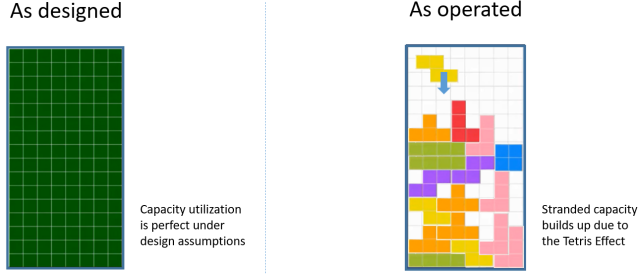Our new report on digital twins for data center operations, out today!
The modern data center lies at the heart of today’s digital global economy, performing computing tasks like e-commerce, communications, search, financial modeling, and artificial intelligence (AI). Data centers undergo constant change, both in the workloads they run 24x7 and the hardware that runs those applications.
Lack of adequate planning and management can lead to under-provisioning, over-heating, and lost capacity, all of which undermine the profitability and sustainability of these critical facilities. Today’s AI and high-performance compute nodes can exacerbate these problems.
When IT loads deviate from the original data center design, stranded power and cooling capacity are the result. A simple analogy helps explain the problem. Most people are familiar with the game of Tetris TM, in which blocks fall at a regular pace, and the player’s task is to place those blocks in the correct orientation, filling up the space as thoroughly as possible.
In the simplest case, the blocks are of uniform size and shape (i.e., they conform precisely to what data center designers specified initially), and it’s easy for the user to fill up the space completely. The example on the left-hand side of Figure 1 illustrates this case. On the right-hand side, the TetrisTM player cannot make the shapes fit perfectly because their shapes are random, and they just keep coming. That leaves gaps (white space) between the shapes, which represent lost capacityin the data center. White space above the colored bricks represents unused capacity.

Figure 1: Lost capacity as illustrated by the game of Tetris
Lost data center capacity is exactly analogous to what are often called “zombie servers” in data centers, which are servers using electricity but doing nothing useful. This time it’s part of the data center itself (the cooling and power infrastructure) that is costing money (and lots of it) but not enabling any useful computing.
In this paper, we describe the challenges data center planners face and the potential for digital twins to help better manage data centers over their useful lives. Combining digital twins with computational fluid dynamics software (models that simulate and predict the behavior of airflow and heat in data centers) helps planners and managers save millions of dollars, reduce energy waste, increase profitability, improve data center reliability, predict failures, and lengthen the useful lifespan of costly data center equipment.
Download my talk titled “Fighting Zombie Data Centers with Digital Twins”.
